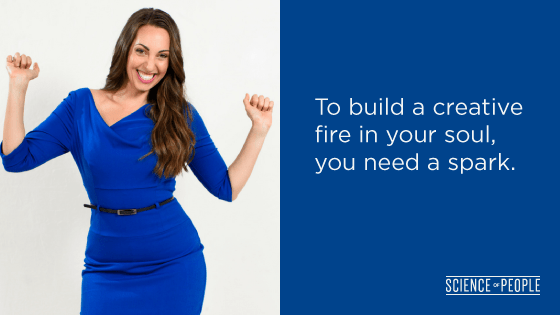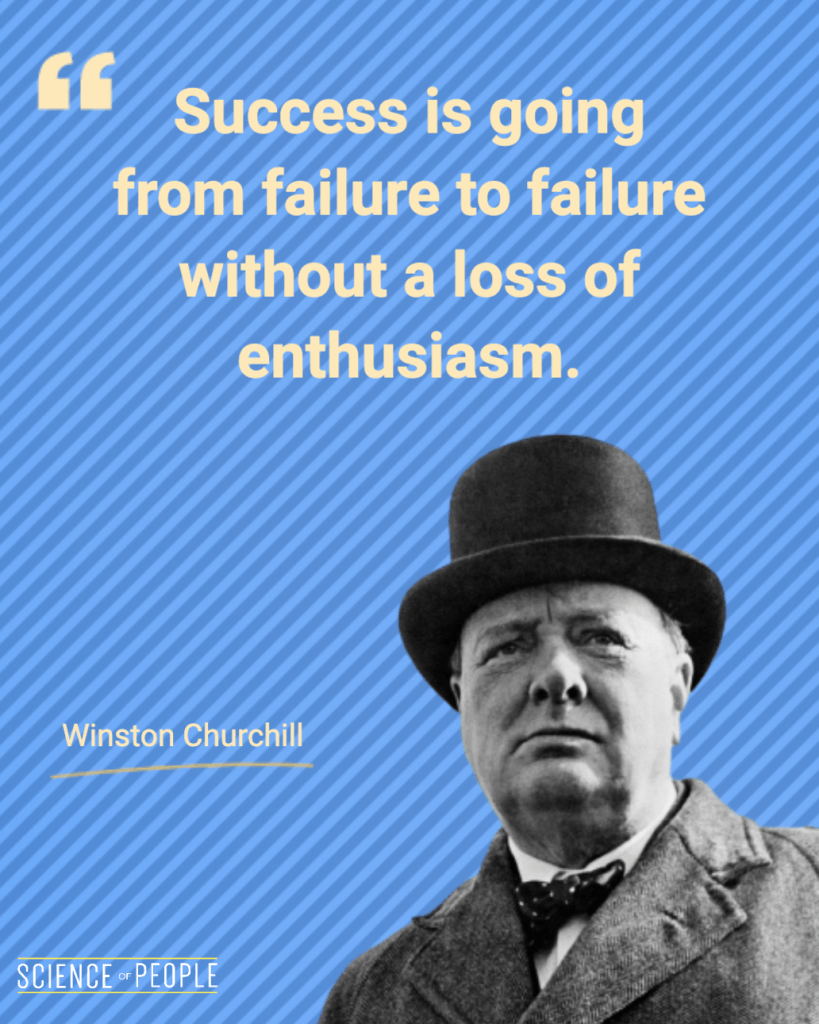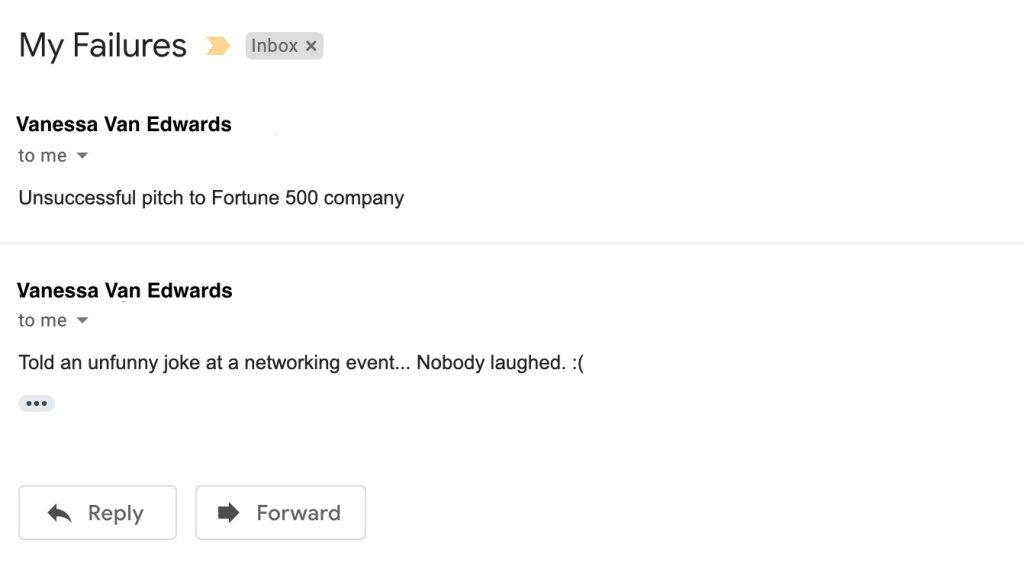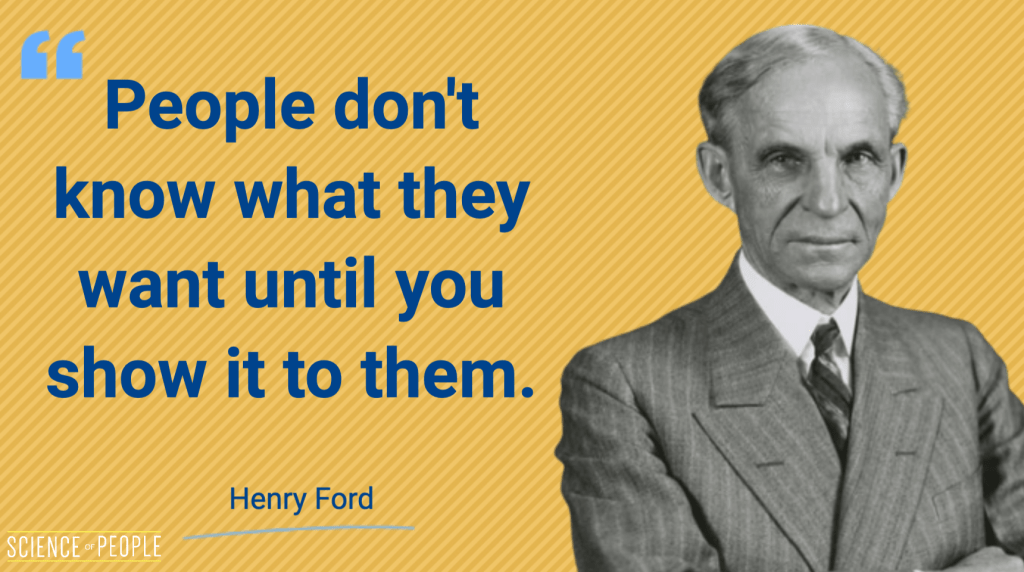If you’re looking to:
- be more creative in the workplace
- increase employee creativity
- lead with creativity and innovation
then you’ll love the tips and tricks you’ll find on this page. I sat down with creative genius Sarah Moyle to talk to her about how to be more creative at work:
Let’s dive in.
18 Ways to Encourage Innovation in The Workplace
What do you think is the #1 trait needed for success?
- intelligence
- curiosity
- discipline
- creativity
According to a study by IBM of 1,500 Chief Executive Officers, they believed the #1 trait needed for success—more so than discipline or even integrity—is d. creativity.
Here’s the problem: Many of us have lost our creative spark. Or worse, our creativity has been drained out of us.
Here’s the good news: You can hone your creativity as a job skill.
Creativity is a muscle that can be trained.
Prompt Your Creativity

One of the best ways to ignite your creativity is to leverage creative prompts or triggers. A great one? LEGOs.
Sounds weird, but follow this…
LEGOs can be a great solution to solve problems in the real world.
Ask, “What traits do you find in a good leader?” And then everyone starts building their answer to this prompt with LEGOs.
People might build a boat to hold and sail ideas. People might build a tower to climb to the top. The goal here is to get people thinking about visual representations of their ideas—and shake up their creative juices.
Once everyone is done building, each person shares how their model tells a story of leadership—they use it to explain and tell a story. (Watch the video above to see Sarah’s leadership LEGO in action.)

Using LEGOs is not only way more fun than simply verbally answering a prompt, but it also levels the playing field. Having everyone build their own model encourages each person to share their unique voice.
I highly recommend having a box of LEGOs in your office or conference room for whenever you need a spark of creativity. You can use LEGOs in team-building sessions, software retrospectives, and several process improvements.
It’s a unique way to tap into the power of nostalgia in adults and offer an opportunity for professionals to experience childlike imagination.
And it doesn’t have to be LEGOs. You can go to your local toy store and ask for recommendations on something you can use to flex your creativity muscles. Play-Doh, anyone?
Bring your new toy(s) to work as an icebreaker or as a team-bonding activity.
5 Levels
If you’re struggling with a business problem, try breaking it down to the basics.
And when I say basics, I mean try explaining it to a 5-year-old.
In the YouTube series 5 Levels, experts take one difficult concept to explain (like nanotechnology or gravity) and try to explain it in 5 levels of difficulty, ranging from professional down to child.
I love this process because it will help get you into a new mindset and hopefully spark a flash of creativity. Try it out or watch the video below for inspiration:
Have Stand-Up Meetings
What’s common in the workplace?
- sitting at the desk
- sitting during meetings
- sitting at lunch
Since we’re sitting all day, why not switch it up? According to a recent study by the Texas A&M Health Science Center, standing can help improve concentration.
Which in turn can get those creative juices flowing.
Get a Learning Buddy
It’s hard to take on creative projects on your own. It’s even harder to tackle a new skill alone. Here’s the answer: a learning buddy.
A learning buddy is someone who can learn a new skill with you. You can share ideas, books, classes, and even practice together. You can do this with technical skills like programming or Excel, creative skills like mosaic, painting, or cartooning, or even social skills like public speaking or negotiating. We love when students take our courses with a learning buddy!
Having a learning buddy forces you to think differently. Employees can meet up with their buddy daily or even throughout the day—at lunch, sharing articles together, and pitching different ideas.
For a bigger punch, try rotating sharing buddies every week.
Side Note: Some people don’t want to be forced to have an office buddy, especially if they’re introverted. Learn the different types of personality your employees have before jumping in.
Get Out of The Office
Along with sitting all the time, being exposed to the same office day after day can be a drag on creativity.
In fact, Harvard ranks access to natural light and views of nature as the #1 office perk.
So yeah, nature is a big deal.
Here’s how to bring nature to the office:
- Maximize natural light. Move the desks near windows, get rid of the blinds, and ventilate the office space.
- Go green. Add plants throughout the office, and consider adding a living greenwall.
- Use natural colors in the office rather than cool colors.
- Incentivize outdoor breaks and lunches rather than indoor ones.
I have a little bamboo plant on my desk and in each of the bathrooms!
Small Wins
Research shows that employees can’t be their most creative if they don’t have an environment that supports experimentation.
This means letting go of the fear of failure.

To allow a culture of failure, I like to aim for small wins.
Take Amazon Prime, for example, which started off small but now nets over 150 million subscribers.
But Amazon Prime didn’t come overnight. Amazon failed many times, from Amazon Destinations to Endless.com. But that one small win made up for all the past failures.
The key is to give people space. Let them make mistakes. And when they do, allow them to find their own solution to the problem.
Failure Threads
I want you to not only embrace failure but study your failures.
Why? We tend to ignore our failures as a form of survivorship bias.
But failures can be a huge source of inspiration and creativity—if you use them properly. Try using “Failure Threads” to learn from your mistakes.
Failure Threads are personal emails you send to yourself with a list of actions you’ve taken that ended in a failure:
- submitting an article to a publisher
- proposing a new idea to your boss
- pitching a new client
All these can be added to your failure thread and revisited to go over what worked and what didn’t.
For example, to start a failure thread, simply send an email to yourself with one recent failure you can think of. Every time you fail, add that to your list.

You can even add a trusted friend or business partner to your email for extra support!
Keep it Warm
Did you know the temperature of an office can impact creativity?
Research shows that warmer temperatures lead to more creative thinking, while colder temperatures keep people alert.
While there might not be a perfect temperature for everyone, dialing in the best warm temperature for you and your colleagues is vital for improved creativity.
Here’s what’s important to note about this tip: Even the smallest things can impact your creativity. You have to start tracking what helps and what doesn’t. For example, I find I get super creative when I drink matcha. Why? I usually drink coffee and matcha just shakes it up, so I feel more creative.
I also read somewhere that people are more creative in wide-open spaces. So sometimes I brainstorm creative ideas on my roof with my team. This works like a charm!
Ambient Noise
Other than temperature, noise levels can also affect creativity.
Work spaces that have a moderate amount of ambient noise actually boost creativity, according to a study.
Why? Because ambient noise makes it slightly harder for our minds to process things. This is great because slightly less brain focus leads to increased creativity.
On the other hand, too-quiet work spaces help us focus, but at the cost of creativity.
Aim for that perfect medium—try using a white noise machine or playing your favorite classical tunes. Alternatively, try one of these free ambient noise mixers:
Another noise hack is to get rid of all phones in the office.
Research shows the #1 noise offender in the office is phone calls—with a whopping 82% of people finding overhearing cell phone conversations annoying.
The best phone calls are the ones others can’t hear.
Try having a dedicated phone call–only room or take it outside to avoid hurting others’ creativity.
Empathetic Designs
Empathetic Designs is an idea-generating technique where innovators observe how people use existing products and services in their own environment.
In other words, see what people are doing NOW and find what they could be doing better.
For example, back when people normally commuted using horses, Henry Ford came in and saw there were problems like being too slow and, well, having to deal with horses (and horse poop). So his opportunity arose and he invented the Model T.

This leads me to the Empathetic Designs technique. Empathetic Designs has 5 steps:
- Observe. Find your ideal customer and see what they’re doing.
- Capture data. Find out why they do it and the problems they encounter.
- Reflect and analyze. After seeing these problems, what could be better?
- Brainstorm. Find possible solutions to these problems.
- Develop prototypes. It won’t be perfect, but make your solution a reality.
Use this 5-step technique the next time you want to innovate.
Welcome Chaos
Is your work day boring and stale?
It doesn’t have to be. Try introducing a little chaos into your daily routine. Chaos can help break up the monotony and add excitement.
Try adding one random task to your work day. It doesn’t have to be work-related, and it can be simple:
- Spend 5 minutes drawing a dinosaur.
- Count how many seconds it takes to fill up water at the cooler.
- Pick a random store you’ve never been to. Visit it during your break.
- Brush your teeth with the opposite hand.
- Have your kids make you breakfast (talk about chaos!).
The key is to introduce one new random thing a day to start thinking out of the box. For a list of more fun and random things, head on over to our article: 40 Productive Things to Do When You’re Bored.
Hobby Room (or Box)
At LinkedIn’s headquarters in Mountain View, California, employees can jam out in a music room to release stress and encourage creativity.
And if you think your office space is too traditional or doesn’t have the funds, try starting small.
Room too much? Start with a creativity box! Go to garage sales and buy old puzzles, buttons, craft sets, paintbrushes, and scrapbooks to see what you can make.
Or try something more active: You can start your own knitting program, host office basketball tournaments, or set up 15-minute yoga classes during breaks.
Dim The Lights
A study posted in the Journal of Environmental Psychology found that people are more creative when the lights are dim.
Why? Dim lights make people feel:
- freer from constraints
- more open to risk
This might be because bright lights make us feel “exposed” and therefore less creative.
If you’re working in an office with bright lights, consider turning them down to boost creativity.
I think that candles work great for this purpose. Sometimes when I am sitting to write a longer article or working on one of my books, I light candles in my office. It gives a nice ambience and smells delightful. I think it also helps me slow down and think more deeply.
Use Creative Conversation Starters
How do your meetings start? How do your phone calls start? Mine all start the same way:
“How’s the weather?”
I’ve got one answer for you—BORING! Instead, try asking a fun conversation starter. These questions break up monotony because they introduce something new, like:
- Working on any personal passion projects?
- Doing anything special this weekend?
- Watch anything interesting lately?
They are casual but just a little bit different. Plus, it’s a great way to introduce creativity to start the day.
The conversations you have outside the office can stimulate creativity inside the office.
Don’t start being creative once you sit at your desk; be creative in the car on the way to work (listen to a new station), when chit chatting with a colleague (try a creative conversation starter), and even when making your breakfast (happy face pancakes, anyone?).
Aim to add more creativity to every interaction you have, so by the time you start your work, your creative juices are flowing.
Read on for a list of the best conversation starters.
Fruits, Not Cookies
A study from the British Journal of Health Psychology found that participants who ate more fruit and vegetables felt happier and more creative at work.
And it’s pretty obvious why—the vitamins, antioxidants, and carbohydrates in fruits are mood boosters, which in turn boost creativity.
However, baked goods and other snacks high in sugar can lead to increased blood glucose and impaired memory.
In other words, a creative crash.
Try keeping a snack bowl of healthy fruits and vegetables around the office and avoid those sugars.
Want to really up-level this tip? Buy unique and creative foods. Last week I got a bag of mangoes instead of my normal bunch of bananas. I looked forward to it, watched a new video on cutting a mango (harder than you think), and it got me thinking all kinds of tropical thoughts.
Next time, try a persimmon, a fig, or some champagne grapes—your creative snack will feed your belly and your soul.
Hot Desking
Traditional office spaces have a specific arrangement, where each employee has their own desk.
Not with hot desking. In a nutshell, hot desking is having fewer desks than employees.
Why? This lets employees sit wherever they want, from open tables or desks to more public spaces like sofas.
The benefit is that employees can feel more at ease and work collaboratively. The downside is that productivity might suffer and there might be more chaos—especially in a huge office.
Warning: Propose this to your teammates as a fun challenge, not like the Hunger Games. This should be inspiring for people, not stressful.
Time Blocks
Creativity isn’t linear. For many people working on a task, the beginning and end are where the most creative magic happens.
That’s because our brains are more relaxed and less focused at the beginning and end of a project, which leads to creative sparks.
So here’s how to think of your workflow: save the creative bits for the beginning and end. So if you’re working in a 1-hour chunk, leave the first and last 10 minutes for creative time, and leave the time in between for grinding.
This will help you take advantage of the maximum creative bursts you might have. To further step it up, try time blocking using the Pomodoro Technique or another time-tracking method.
Track the time you’ve spent on one project, then move on to the next. Time blocks help you juggle different projects while maximizing your creativity.
Bonus #1: How to Be More Creative in a Remote Workplace
If you’re a remote worker, there are endless possibilities to work:
- quietly at the desk
- at a cafe
- on the sofa with your cat
To truly be creative, you should match your work style.
Do you like to be alone at your desk? Surrounded by people? Take our remote work quiz to find your remote work style:
Bonus #2: The Fallback
Tried everything in this guide but still feeling stuck? Then you need a fallback.
Fallback: noun. A safety net where you feel comfortable retreating to and where you feel the most creative.
Your fallback doesn’t have to be at work—for most people, it’s being at home, spending time with their best friend, or doing their favorite hobbies.
Sometimes we struggle to find creativity at work. And that’s OK!
As long as we’re feeling creative in other areas of our lives, that’s what’s important.
For example, Sarah Moyle created whiteboard animations like this one in her free time:
And as a fallback to your fallback (yes, there is one!), you might want to find a job that makes you happier and more creative.
But in the end, I know you can do it.
Stay creative, and be yourself!
To your creative success,
Vanessa
